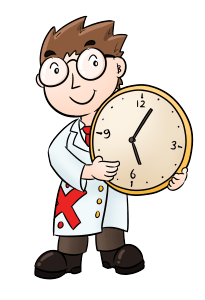- < Experiment 5
-
Experiment 6 v4
- Experiment 7 >
Adding and subtracting fractions using a clock

How can you use a clock to work with fractions?
Purpose
This experiment gives children an opportunity to experiment with adding fractions using the concept of hours on a clock face.
The child will learn that the easiest way to add halves, thirds, quarters, sixths and twelfths is to convert everything to twelfths first.
You need to know
- what the fraction a half (½) is
- what the fraction a third (⅓) is
- what the fraction a quarter (¼) is
- what the fraction a sixth (⅙) is
- what the fraction a twelfth (1/12) is
- the difference between clockwise and anticlockwise
You will need

Steps
- Set the hands of your clock so both the hour and minute hands point to 12.
-
Wind the minute hand forwards (clockwise) until you get to 1 O'Clock.
As the minute hand moves past each number, think about what fraction of the hour this represents.
- Reset the clock to midnight.
-
Wind the clock forwards (clockwise) so the minute hand points at the 3.
The minute hand has rotated through 3/12 (or 1/4) of an hour.
-
Wind the clock forwards so the minute hand moves another three places to the 6.
The minute hand has rotated another 3/12 (or 1/4) of an hour to 6/12 (or 1/2).
-
Wind the clock backwards (anticlockwise) so the minute hand moves back three places to the 3.
The minute hand has rotated back 3/12 (or 1/4) of an hour to 3/12 (or 1/4).
Hint
Moving the minute hand forwards (clockwise) is like adding the fractions.
A quarter turn (from 12 to 3) plus another quarter turn (from 3 to 6) is the same as a half turn (from 12 to 6).
Hint
Moving the minute hand backwards (anticlockwise) is like subtracting the fractions.
A half turn (from 12 to 6) minus a quarter turn (from 6 to 3) is the same as a quarter turn (from 12 to 3).
Questions
-
Move the minute hand forwards (clockwise) from 12 to 1. What fraction of an hour is this?
Hint
How many times would you need to do this for the minute hand to get back to 12?
-
Use your clock face to work out 1/3 + 1/6.
Hint
Think about how many twelfths there are in these two fractions.
- What is 3/4 - 1/3.
Expected answers
-
This is 1/12 of an hour.
If you rotate the minute hand by this amount 12 times it gets back to where it started.
-
Wind the clock from 12 to 4 to represent the 1/3.
Wind it another 2 places from 4 to 6 to represent adding 1/6.
So the answer is 6/12 or 1/2.
-
Wind the clock from 12 to 9 to represent the 3/4.
Wind it back 4 places to 5 to represent subtracting 1/3.
So the answer is 5/12.
Explore further (optional)
You have seen how you can use the numbers round a clock face to add and subtract halves, thirds, quarters, sixths and twelfths.
How can you use this idea to help you work with fractions without using a clock?
Will this work with all types of fractions?
Tips for further exploration
All these types of fractions can be represented as twelfths.
So convert all the fractions to twelfths before adding or subtracting them, then simplify the result if possible.
This will only work with fractions that can be represented as twelfths (so, for example, it won't help if you need to add 1/5). However, you can use the same idea but with a different common fraction.



